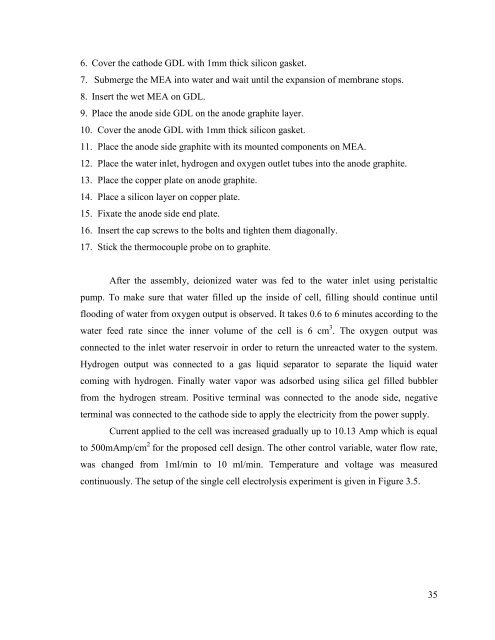hydrogen production from water using solar cells powered nafion ...
hydrogen production from water using solar cells powered nafion ...
hydrogen production from water using solar cells powered nafion ...
You also want an ePaper? Increase the reach of your titles
YUMPU automatically turns print PDFs into web optimized ePapers that Google loves.
6. Cover the cathode GDL with 1mm thick silicon gasket.<br />
7. Submerge the MEA into <strong>water</strong> and wait until the expansion of membrane stops.<br />
8. Insert the wet MEA on GDL.<br />
9. Place the anode side GDL on the anode graphite layer.<br />
10. Cover the anode GDL with 1mm thick silicon gasket.<br />
11. Place the anode side graphite with its mounted components on MEA.<br />
12. Place the <strong>water</strong> inlet, <strong>hydrogen</strong> and oxygen outlet tubes into the anode graphite.<br />
13. Place the copper plate on anode graphite.<br />
14. Place a silicon layer on copper plate.<br />
15. Fixate the anode side end plate.<br />
16. Insert the cap screws to the bolts and tighten them diagonally.<br />
17. Stick the thermocouple probe on to graphite.<br />
After the assembly, deionized <strong>water</strong> was fed to the <strong>water</strong> inlet <strong>using</strong> peristaltic<br />
pump. To make sure that <strong>water</strong> filled up the inside of cell, filling should continue until<br />
flooding of <strong>water</strong> <strong>from</strong> oxygen output is observed. It takes 0.6 to 6 minutes according to the<br />
<strong>water</strong> feed rate since the inner volume of the cell is 6 cm 3 . The oxygen output was<br />
connected to the inlet <strong>water</strong> reservoir in order to return the unreacted <strong>water</strong> to the system.<br />
Hydrogen output was connected to a gas liquid separator to separate the liquid <strong>water</strong><br />
coming with <strong>hydrogen</strong>. Finally <strong>water</strong> vapor was adsorbed <strong>using</strong> silica gel filled bubbler<br />
<strong>from</strong> the <strong>hydrogen</strong> stream. Positive terminal was connected to the anode side, negative<br />
terminal was connected to the cathode side to apply the electricity <strong>from</strong> the power supply.<br />
Current applied to the cell was increased gradually up to 10.13 Amp which is equal<br />
to 500mAmp/cm 2 for the proposed cell design. The other control variable, <strong>water</strong> flow rate,<br />
was changed <strong>from</strong> 1ml/min to 10 ml/min. Temperature and voltage was measured<br />
continuously. The setup of the single cell electrolysis experiment is given in Figure 3.5.<br />
35

















